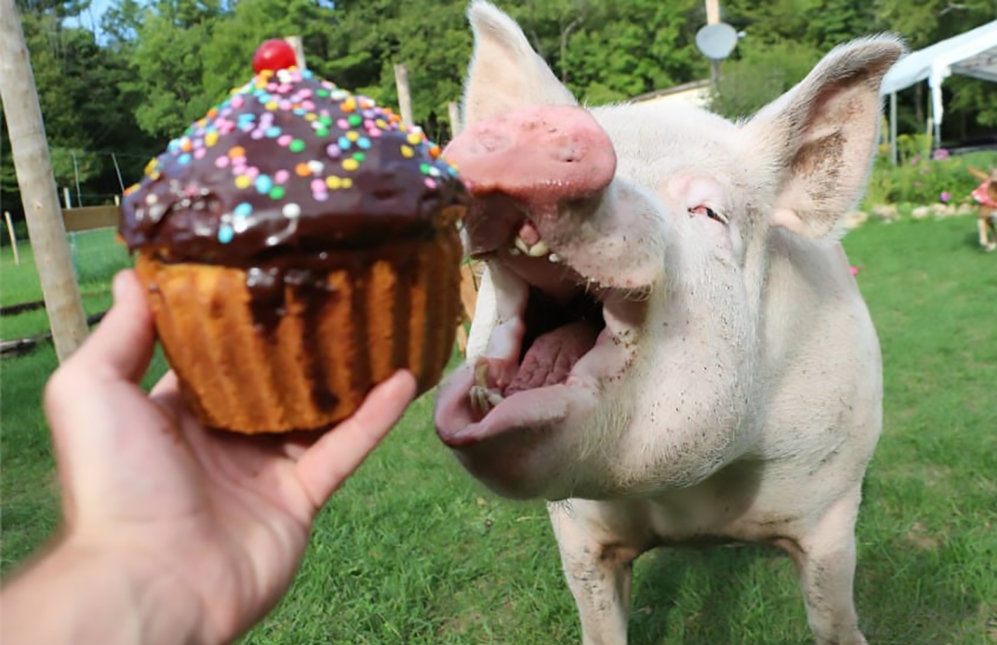Pigs suffer on farms – even in the UK. Learn more about factory-farmed pigs in this blog.

Meet Esther
If you think there is something fundamentally different about farmed animals than, say, a dog or a cat, then you probably haven’t met Esther the Wonder Pig.
Esther was bought as a pet micro pig but she turned out to be the same huge breed of pig that is reared for flesh on farms worldwide.

Esther was a huge character, loved to sleep, eat, run in the fields and cuddle up with the dogs, cat and humans in her family.
She was given the chance to show her intelligence, personality and zest for life, but all pigs have the same capabilities as her.
They are more intelligent than the dogs with whom we share our homes and can solve problems as well as chimpanzees.[1]
Pigs can also learn words and phrases, be house trained, and even play computer games. We just don’t give them the chance to do so.
How are Pigs Farmed?
Most pigs in the UK are reared on intensive farms. For those used for breeding, their life is a cycle of forced impregnation, followed by up to five weeks in a cage so small they cannot turn around during which time they will give birth. Very soon, their piglets are taken from them, and the cycle begins again.
People think that crates are banned for pigs in the UK but they are not. The farrowing crate, where pigs give birth and are locked until their piglets are removed, is legal and widespread.
The gestation crate, where pigs are locked for the duration of their 4-month pregnancy, is banned in the UK. However, meat from countries where this crate is still legal is sold in the UK.

In the wild, pigs would find a private place and build a nest in which to give birth. On farms, all they have are the metal bars that prevent them from moving and a concrete floor that causes painful pressure sores.
In desperation, they go through the motions of nest-building inside their cage but it is, of course, utterly futile.[2]
When born, the piglets suckle from their mother but she is not able to reach them and nuzzle them. If they are sick, all she can do is watch them die.
She will be kept in this confinement for a further 28 days until the young are taken from her. She will be returned to a pen, and will soon be impregnated again.
And again, and again, until she is exhausted and her body can no longer endure the strain. Then she will be sent to slaughter as a ‘cull sow’, and her body turned into low-quality products like pork pies and sausages.
Keeping pigs alive in the filth and squalor of factory farms requires a lot of veterinary medication. This shocking photo was taken by Animal Aid investigators at a Somerset pig farm.

Piglets suffer too
Pigs have been bred to have as large a litter as possible, and many of their piglets are still-born or die at birth, or soon after.
They rarely receive veterinary care. Investigators have found their tiny bodies abandoned in the aisles of the units and dumped in bin bags.

In nature, weaning is a gradual process, often taking three to four months. On farms, the early separation between mother and piglets causes distress to them both. It is quite common for them to call out to one another in the vain hope of being reunited.[3]
At this stage, most piglets in the UK will have their tails docked[4] with heated pliers. If done during their first week of life, they do not have to be given an anaesthetic.
As Compassion in World Farming found:
“An estimated 2.8 billion pigs have had their tails docked since the EU ban came into force in 2003, and according to a recent report by AHDB Pork, 70% of pigs in the UK are still tail-docked.
The industry is clearly flouting the law by continuing to perform these practices.”
They will also have their teeth clipped or ground down. The pig industry claims that such procedures are necessary to prevent piglets from injuring each other.
However, pigs rarely harm one another when living wild. It is a problem related to their stressful living conditions where overcrowding and boredom are rife.
Castration is not so common on UK farms, as most pigs are slaughtered before they reach the age where ‘boar taint’ (an unpleasant taste of a mature male pig’s flesh) becomes a problem for those who eat meat.
But other countries still castrate piglets without anaesthetic and their meat is on sale in the UK.
In 2015, Viva! investigators filmed at a farm that boasts of Red Tractor accreditation and produces 20,000 pigs a year for supermarkets, including Morrisons. What their cameras found was truly shocking.
Live transportation
It is often said that we need more slaughterhouses to stop the long-distance transportation of live animals. But animals are slaughtered where they reach the best price, and that is why it is common for pigs farmed in Aberdeen to be sent to slaughter in Essex.
They are transported for long distances in all weathers, frequently with poor ventilation and temperature control. Pigs are sensitive to high temperatures and humidity and, because they only sweat through their snouts, are prone to dehydration and heat stroke.[5] These stressful journeys are utterly inhumane.
How are Pigs Slaughtered?
Pigs should be stunned before slaughter, either with an electric current through their brains or by being immersed in a gas. Neither method is guaranteed to be effective.
Animal Aid found that more than 99 per cent of pigs in two slaughterhouses were stunned incorrectly with electric tongs,[6] while investigators in Europe and in Australia have documented pigs clambering over one another inside the gas chambers gasping for breath.
After stunning, pigs are shackled and hoisted upside down by their back legs. Their throats are then slit. It is not illegal to slaughter pigs in front of one another.[7] [8]
A kinder way
Around nine million pigs are slaughtered every year in the UK, each of them with a character as big as Esther’s, and with their own individual personality traits, and their own friendships and preferences.
Pigs are like dogs in many ways. They are playful and fun-loving, intelligent and quick to learn. Imagine just for a moment that we kept dogs in cages inside the filth of a factory farm.
That we gave them nothing to do, denied them their basic needs, and never let them see the sun or breathe fresh air. And then, when we had made them too weak to breed from, we painted a cross on their backs and shipped them long distances to the slaughterhouse.
We just wouldn’t do it. So, why do we do it to pigs?

References
1 Ellie Zolfagharifard, ‘Move over Lassie: IQ tests reveal pigs can outsmart dogs and chimpanzees’, Daily Mail, 13 June 2015. Available at: http://www.dailymail.co.uk/
2 ‘Why is nest-building behaviour so important?’, FreeFarrowing.org. Available at: https://www.freefarrowing.org/ [Accessed 19 June 2017]
3 Daniel Weary and David Fraser, ‘Calling by domestic piglets: reliable signals of need?’, Animal Behaviour. 50 (4), 1047-1055, 1995.
4 ‘The welfare of pigs’, RSPCA, 2009.
[Accessed 19 June 2017]
5 ‘Transport of Livestock’, Humane Slaughter Association, 2013. Available at
https://www.hsa.org.uk/ [Accessed 19 June 2017]
6 ‘Briefing: CCTV in Slaughterhouses’, Animal Aid, February 2017
7 Jay Akbar, ‘Revealed: disturbing footage of pigs struggling to breathe as they’re killed by CO2 stunning methods being used by supermarket abattoirs’, Daily Mail, 17 Feb 2015. Available at: http://www.dailymail.co.uk/
8 ‘If this is the “best”, what is the worst?’, Animals Australia, 2010.




















